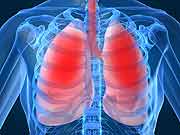
WEDNESDAY, April 20 (HealthDay News) — Researchers have identified a genetic variant that’s found in at least 59 percent of those who have pulmonary fibrosis, a deadly lung disease that typically kills within a few years of diagnosis.
Those with the gene variant had nearly 7 to 22 times the risk of contracting the lethal disease.
For the study, the researchers did a genome-wide linkage scan of 82 families with pulmonary fibrosis of an unknown cause. This type of scan typically looks at how inheritance patterns of multiple affected families are related to several hundred markers throughout the DNA.
The researchers zeroed in on chromosome 11, where they found a common gene variant.
The researchers then compared the results to the genomes of 83 people with familial pulmonary fibrosis (meaning it runs in their family), 492 people with idiopathic pulmonary fibrosis (the type for which there’s no known cause) and 322 people without lung disease.
More genetic mapping showed that about 59 percent of people who have familial pulmonary fibrosis (also known as familial interstitial pneumonia) and 67 percent of those with the idiopathic type had the particular variant, or polymorphism.
Only 18 percent of those who did not have lung disease had that variant.
Pulmonary fibrosis involves rapid and progressive scarring of the lungs, making it increasingly difficult to breathe. It develops mostly in middle-age and older adults, according to the Coalition for Pulmonary Fibrosis. Each year, about 40,000 people in the United States die of the disease.
“This gene variant contributes to the development of disease in 60 percent of patients with pulmonary fibrosis,” said the study’s senior author, Dr. David Schwartz, chairman of the department of medicine at the University of Colorado and director of the Center for Genes, Environment & Health at National Jewish Health in Denver.
So what does the MUC5B gene do in the body? It is involved with mucus production it codes for it, in fact — and is expressed in the air sacs deep within the lungs.
In people with the variant who had pulmonary fibrosis, expression of the MUC5B protein was 14.1 times higher than in those without lung disease. The protein produced by MUC5B was also found at higher concentrations in the injured sections.
Though pulmonary fibrosis was believed to be a problem with the lung tissue itself, the new research suggests that pulmonary fibrosis is actually a problem of the airways, Schwartz said.
That could open the door to new treatment possibilities, including inhaled medications, he said.
“We don’t have an effective treatment for the disease, and we don’t have an effective treatment because we’ve been focusing on the wrong target,” Schwartz said. “This discovery will help us focus on the right target and develop or try treatments that are directed at the mucus in the lung and the repair process in the lung associated with excessive mucus production.
The research is reported in the April 21 issue of the New England Journal of Medicine.
Dr. Marylyn Glassberg, an associate professor of medicine and surgery and director of the Interstitial Lung Disease Program at the University of Miami Miller School of Medicine, said that the researchers have found a strong association, but they haven’t proven causality.
“They make a strong case that this could be a very important contributor in terms of the development of the disease,” Glassberg said.
But the findings do not explain why about 9 percent of people without lung disease have the variant but not the disease or what triggers the disease in those who get it.
It’s likely that other genes, illnesses or environmental factors play a role, Glassberg said. Conditions such as lupus and scleroderma are risk factors for the disease, as is smoking and air pollution, she said.
“This is a very important study, but it’s not causative,” Glassberg said.
It’s possible that too much MUC5B protein makes it increasingly difficult for the mucus in the lung to clear foreign particles, such as cigarette smoke, dust and air pollution or to repair itself when it’s exposed to pollution and other irritants, Schwartz said.
Another theory is that the MUC5B polymorphism may result in the protein being produced in parts of the lung where it shouldn’t be, so that it acts not as a protector but as a toxin.
Besides opening the door to other treatments, Schwartz said, the study’s findings might also enable genetic testing of people who have the disease in their family.
In addition, researchers found that those who’d inherited one copy of the variant from their parents were seven to nine times more likely to have disease and those with two copies of the variant had up to a nearly 22-fold increased risk.
A genetic test for pulmonary fibrosis would be welcomed by many, such as Teresa Barnes, vice president of patient outreach and program support at the Coalition for Pulmonary Fibrosis. Her father was diagnosed with the disease in 2002 and died within two years. Within a few years, his sister and two other brothers also died of the disease.
“It’s excruciating to watch,” Barnes said. “Someone you love is suffocating. You can’t make it go away. You can’t stop it. You feel really helpless, and you feel really hopeless.”
Barnes, who has a 7-month-old daughter, said she wonders if she or her daughter are destined to get the disease.
“It scares the life out of all of us,” Barnes said. “If 100 percent of the generation before you died from something, believe me, you’re afraid.”
More information
The Coalition for Pulmonary Fibrosis has more about pulmonary fibrosis.
SOURCES: David Schwartz, M.D., chairman, department of medicine, University of Colorado, and director, Center for Genes, Environment & Health, National Jewish Health, Denver; Marilyn Glassberg, M.D., associate professor, medicine and surgery, and director, Interstitial Lung Disease Program, University of Miami Miller School of Medicine, Miami; Teresa Barnes, vice president, patient outreach and program support, Coalition for Pulmonary Fibrosis; April 21, 2011, New England Journal of Medicine

